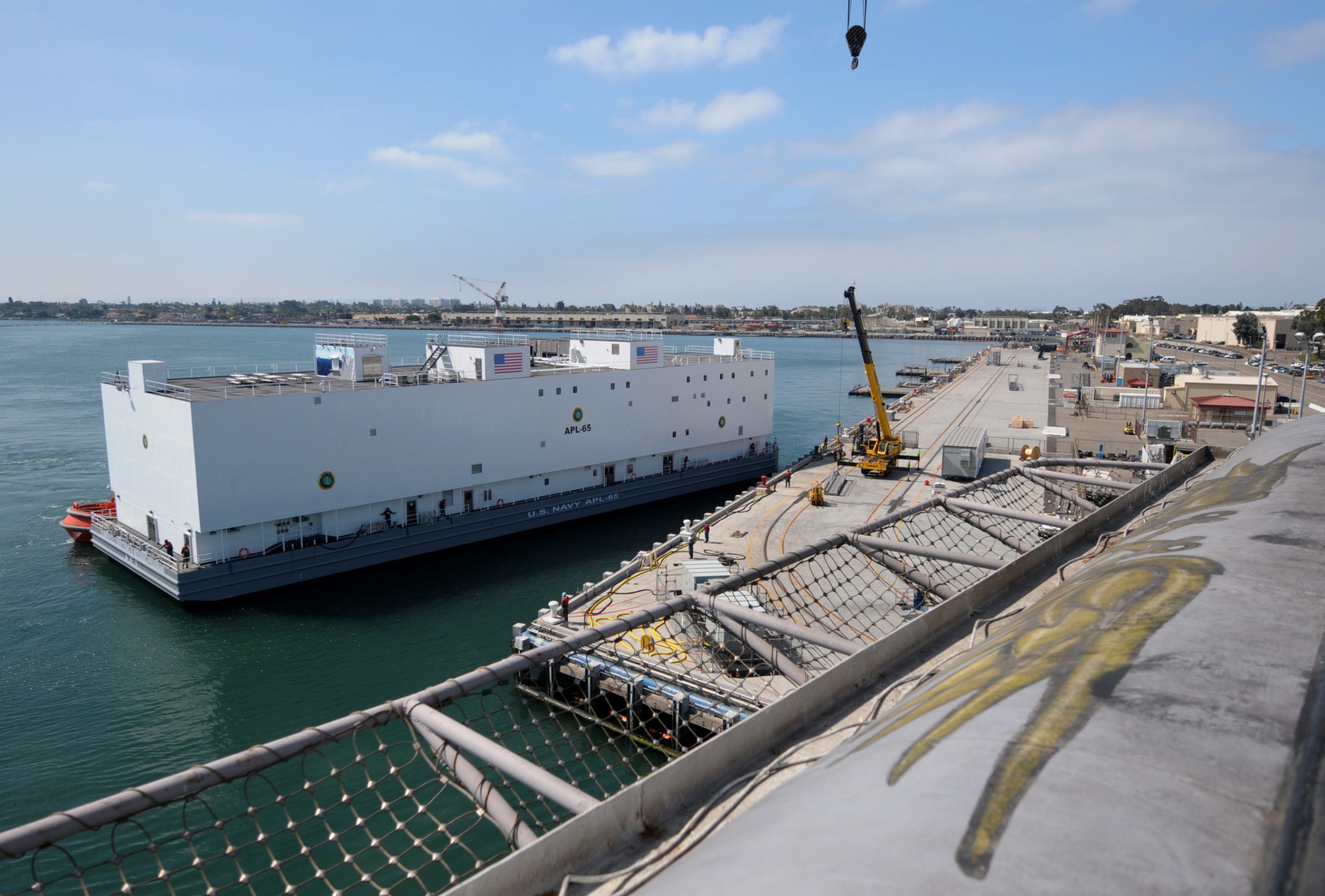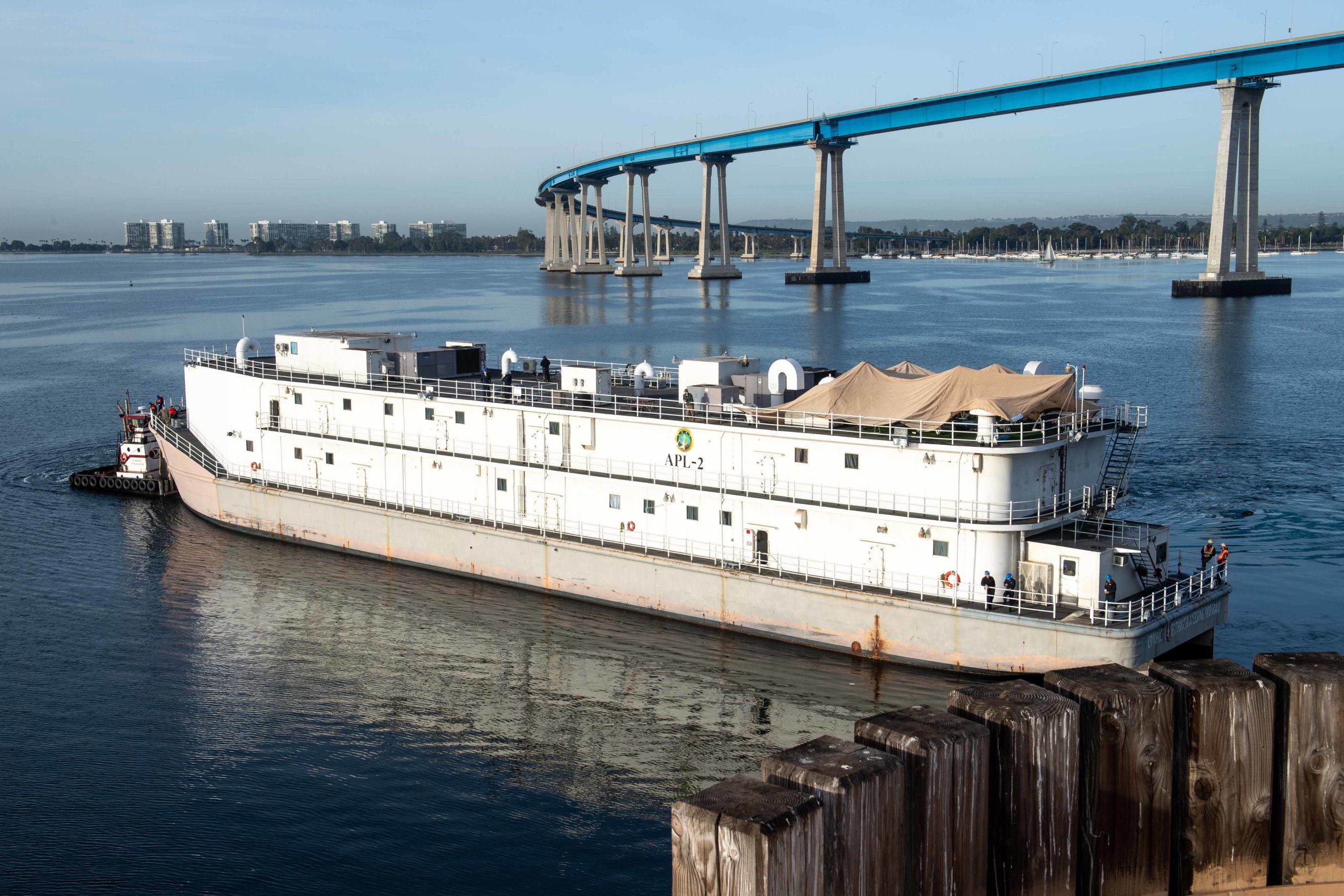
SAN DIEGO, Calif. — For the first time in more than 20 years, sailors moved off their ship going into major repairs are getting better digs with new berthing barges.
Berthing barges have been a continuous issue for the sea service. Every time a ship’s maintenance period gets extended, the Navy loses a berthing barge needed to house the unaccompanied sailors of the next ship it’s scheduled to support. With the average age of the Navy’s berthing and messing barges pushing 40 – the oldest is 56 –it’s likely the barge the sailors get to live, work and dine while they’re doing a shipyard or pierside maintenance availability just might be older than their ship’s skipper.
This year, though, barge readiness is looking up, as budget realignments will fund housing for more sailors, more maintenance and modernization, and provide state-of-the-art amenities in two new classes of barges entering the fleet, a senior official told the Association of Naval Engineers at the group’s annual conference.
The Navy has taken delivery of four new barges, the first of the APL-67 class of Auxiliary Personnel Lighter berthing and messing barges that will replace 27 older barges. A fifth barge, APL-70 – is under construction by Bollinger Mississippi Shipbuilding (formerly Halter Marine).
“These are the first new barges the fleet has gotten since 2000,” Rear Adm. William Greene said during a keynote address at the 2023 Fleet Maintenance and Modernization Symposium in San Diego.
In 2000, the Navy received just one barge, APL-61, to support 1,000 sailors for an aircraft carrier, he said.
“A class of one. So it has been long overdue to get these new barges online,” he said.
The new APL-67 is a state-of-the-art berthing barge, Greene said during his keynote speech.
“It can berth about 600 sailors. It can feed 1,100 sailors three meals a day,” he said. “It’s got modular berthing. It’s based on cruise ship berthing; there’s no open-bay berthing.”
The first of the newly-designed barges was sent to Yokosuka, Japan, while the latest, APL-70, arrived in April in Norfolk, Va., to support amphibious assault ship USS Kearsarge (LHD-3) while the ship goes through a planned maintenance availability. Another one arrived in San Diego to support USS Makin Island (LHD-8) through a selected restricted availability. The ship’s CO “is very happy with the barge,” Greene said.
Along with berthing for unaccompanied sailors, the new barges also provide office space and amenities found on ship, including a medical center, laundry, barber shop and a fitness center along with a local area network and hundreds of networking hubs so sailors have ease of online access.
“The berthing barge becomes the home away from home’ for our sailors,” Greene told the ASNE audience.
Already, for sailors living through a maintenance availability at a commercial shipyard, the Navy has been pushing out to commercial shipyards a pierside connectivity system called the Wireless Connectivity Bridge, he said. That’s closed a gap especially on ships or along waterfronts that have poor commercial cellular connectivity.
All those investments matter a lot to sailors.
“I can already see the excitement from the crew when we realized that we will be on a brand new barge,” Chief Logistics Specialist Errmon McClarin, the Kearsarge command climate specialist, said in an April Navy news story about APL-70’s arrival. “This is a great change compared to the rugged environment we experience on the ship.”
Sailor quality of life has been at the forefront of the service’s mind following the investigation into living conditions for sailors aboard USS George Washington (CVN-73) after several sailors died by suicide. According to the investigation, junior sailors aboard the carrier had some of the toughest living conditions in the military.
The investigation and review by Fleet Forces commander Adm. Daryl Caudle laid bare the neglect to crew quality of life and conditions junior sailors endured in berthing, shore housing and aboard ship through a six-year-old mid-life overhaul and refueling. The unexpected delays and extensions they endured create a ripple effect that affects crews on other ships going into a maintenance availability.
“Fleet barges are out-of-date and contain numerous maintenance challenges. They do not have internet capability and some lack appropriate furniture for the crew. USFFC has been able to meet demand for barges, but there is not enough time for proper upkeep,” the report stated. It added: “The current program allows USFFC to refurbish barges but not redesign them.”
That lack of adequate barges and shore accommodations — in part due to a priority shifting those to USS John C. Stennis (CVN-74) as it entered the yard for its mid-life upgrade — forced some 400 sailors to move aboard George Washington amid continuing repairs.
“We failed to stop and account for the true costs of this process on our sailors. … We understand the ‘stuff’ and we can quantify it, test it, improve upon it, and master it almost to the level to where it becomes predictable. This is the area in which we are most comfortable,” Naval Air Force Atlantic commander Rear Adm. John Meier said in his endorsement of the investigation.
“While extremely important, it pales in comparison to how we take care of the people.”
Old barges

A ship in a maintenance availability becomes an industrial work zone. Its shipboard habitability systems including potable water, restrooms and showers aren’t available. Most work spaces and the galley aren’t available amid utility work, repairs and upgrades of shipboard and combat systems.
The ship’s force has to maintain a 24-hour duty station, so a barge berthed by the ship provides the workspace for the duty section and keeps the first responders near if any emergency happens aboard the ship.
“These berthing barges are absolutely vital to the success of our CNO Maintenance Availability,” said Greene, who also took the reins as Navy Regional Maintenance Center commander on Aug. 23, following a tour as director of fleet maintenance with U.S. Fleet Forces Command.
It’s also an aging inventory of about 70 barges.
“Many of our existing barges are passed their service life,” Greene said. “This really drives up sustainment costs, and it drives up the sustainment timelines when they go into the availability.”
A barge’s service life is about 40 years. In the fleet, the average barge is 56 years old, Greene said. Some of the barges were commissioned in 1942.
Most “don’t meet today’s standards. They don’t have the configuration for mixed-gender crews, for example. They don’t have local area network hubs; they have a few of them, but they don’t have enough,” Greene said.
And as older barges undergo repairs and upgrades, such as for mitigating leaded paint, “that drives the cost of the program,” he noted.
Low Inventory, High Demand

Along with the new APL-67 class, the Navy also is slowly replacing its older, smaller barges with a new YRBM-57 class to provide berthing and messing for cruisers, destroyers and smaller amphibious ships. The first three of that class are scheduled to be sent to San Diego, with the initial barge planned for April 2024, Greene told the audience.
The first YRBM contract was awarded in 2022 to Conrad Shipyard LLC, a Louisiana repair and shipbuilder, which will build five barges. The first is scheduled to be delivered to the Navy in the first quarter of 2024, the company announced Aug. 24.
Still, the Navy’s inventories of barges “are inadequate to meet the demands,” Greene said. With “the demand signal with all the CNO availabilities that we have going on, we generally need a barge for each one – and that gets compounded when you have (an) availability extension.”
The Navy plans and schedules maintenance availabilities, matching the flow of ships and submarines in and out of shipyards or pierside for repair with barges for crew support as well as barges getting their own maintenance, repairs and upgrades.
“This window in-between, that’s where barge maintenance goes. So when one of those avails gets extended – and there’s a barge attached to it – that time to do maintenance on the barge gets really compressed,” Greene said. “And that gives us kind of two options. We either do a hot turnover on the barge – Right? Very undesirable, because the gaining crew is usually unhappy.”
Or since the barge’s onboard systems including the galley may need work, “you have to tell the next ship, ‘Your barge is going to be late.’ What does that mean? That means you can’t pull systems down, you can’t move the crew off… and it impacts the CNO Availability,” he said. “So a barge is a critical piece of the puzzle for executing successful CNO avails.”
Funding Fixes

NAVSEA officials hope to limit those situations, and recent tweaks to some budgeting practices just might spell some relief, Greene indicated, by making funding more available to modernize and sustain the existing fleet of barges.
“We found there were several programmatic issues that were driving sub-standard outcomes to our fleet berthing barge program,” he said.“First, there were regular shortfalls in barge sustainment funding.”
That’s money to take barges offline and put them through life-cycle management programs. It’s about a $30 million a year for Fleet Forces, he added, “not huge.”
But with “getting 74 percent of the requirement, year after year,” he noted, barge readiness “just keeps going down.”
Moreover, the Fleet’s Unaccompanied Housing Program was in the same budget line item as barge sustainment, Greene said.
“The Unaccompanied Housing is a must-pay bill,” he said.
That means there is not a lot left for barges, Greene said. Those shortfalls add up and create delays in needed maintenance of barges.
“The barges are not complicated,” he said. “It’s basically a box. There’s no combat system, there’s no propulsion system. It shouldn’t be that hard.”
This year, however, for the fiscal 2024 budget, the Navy separated budget lines for unaccompanied house and barge sustainment.
“For the first time in a long time,” he said, “our sustainment funding is fully funded.”
As proposed, the Navy’s fiscal 2024 operations and maintenance budget requested about $30 million for off-ship berthing costs and $14.7 million for barge operations and overhaul.





